 Airservices Australia says the benefits of its ‘Accelerate’ restructuring program will allow it to deliver real cost reductions to its aviation industry customers across the next five years.
Airservices Australia says the benefits of its ‘Accelerate’ restructuring program will allow it to deliver real cost reductions to its aviation industry customers across the next five years.
The government-owned air navigation service provider and aviation firefighting operator released its latest five-year corporate plan on Tuesday, detailing its forecasted financial performance through to the end of the 2021-22 financial year. The plan projects that despite only modest increases in Airservices’ revenues over the five-year period that earnings before interest and tax (EBIT) will rebound strongly, to over $100 million from 2017-18 onwards.
“The plan embeds the cost savings delivered through our new operating model, enables real price reductions of around 10 per cent to be delivered to industry over the next five years, and funds key investment programs to deliver important safety and service improvements,” reads the corporate plan.
“Today our prices are the same as they were in July 2015. Reflecting the delivery of a more efficient operating cost base through our new operating model, this plan maintains weighted average prices at existing rates, delivering our customers real price decreases and improved service value through to 2021-22.”
Airservices’ customer charges are set under five-year Long Term Pricing Agreements (LTPAs). The current pricing agreement came into effect in October 2011 while a new LTPA, which sought to raise charges for air navigation services by an average of 3.3 per cent a year over the five years from 2016, was deferred.
The federal government also stands to benefit from the turnaround in Airservices’ financial performance, receiving a dividend of almost $9 million in 2017-18 rising to around $20 million in subsequent years.
“With capital expenditure funding requirements remaining high, this plan maintains current dividend payout ratios at 30 per cent of net profit after tax. This is projected to return an average of $17 million in dividends each year,” the plan reads.
Much of Airservices’ capital expenditure over the five-year period is for the OneSky air traffic management system.
“Over the five-year planning period, OneSky and its enabling projects account for $652 million, or 61 per cent, of the total spend.”
The balance of $421 million will be “to improve services and sustain current infrastructure as well as to support new runway operations at Brisbane, Melbourne, and Perth”.
The plan shows for the just completed 2016-17 financial year that Airservices was forecast to post an EBIT of $59.8 million, following a net loss after tax of $127.3 million in 2015-16, the organisation’s first loss in its 20-year history and one largely due to one-off restructuring costs, including staff redundancies.
The corporate plan shows staff costs for 2016-17 to be a forecast $678.8 million, falling to $640.8 million in 2017-18 and rising modestly thereafter.
“Over 2016-17 we successfully transitioned to a new, simpler operating model based on customer needs, with less bureaucracy and more accountability. Our focus is now on sustaining and improving our organisational performance,” the corporate plan notes.
Under Accelerate Airservices’ workforce was to be cut from 4,500 to 3,600.















